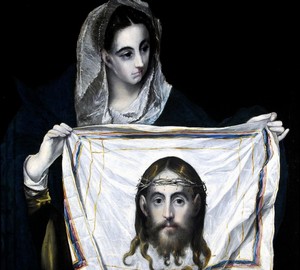
Description of the picture:
Saint Veronica – El Greco. C. 1579
El Greco addressed the theme of the sacred shawl several times. In a painting painted around 1579, the brooding look of an aristocratic st. Veronica is set aside, which allows the viewer to focus on the image of Christ imprinted on the shawl that she shows. Christ looks directly at the viewer, his features are calm and refined, and not distorted by wounds or pain.
Such an idea of the human image of Christ is similar to the majestic miraculous Savior – an image revered by Orthodox Christians, with whom El Greco, as a Cretan, should have been familiar. Like Veronica’s handkerchief, the shroud was a piece of cloth on which the image of Christ was wonderfully imprinted when he brought it to his face, so it is believed that it conveys its true features. Both the shroud and the shawl of Veronica were important relics for medieval Christianity, but in painting the image on the shawl more often represents only the face of Christ with trickles of sweat and blood, which encourages the viewer to focus on thoughts about the sufferings of Christ, accepted by him for the atonement of human sins.
ST VERONICA. In the apocryphal gospels, Veronica is referred to as a woman who suffered from bleeding and was healed by touching the edge of Christ’s garment. It was also known that she had an image of the face of Christ, which, according to legend, she received by wiping sweat from his face with a piece of linen cloth when Christ carried the cross to Calvary: his face was miraculously imprinted on this piece of cloth. The fabric, called Veronica’s handkerchief, subsequently ended up in Rome and became an important relic of the Basilica of St. Petra. The name “Veronica” can be considered to be derived from the Latin words faith icons, meaning “true image.” This saint is depicted holding her handkerchief, as in the picture of El Greco, or standing among the disgusting crowd that surrounded Christ before his crucifixion, standing out by the grace of her appearance, as in the painting of Bosch (c. 1450-1516)."